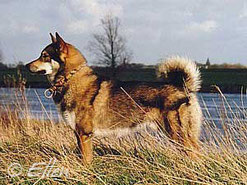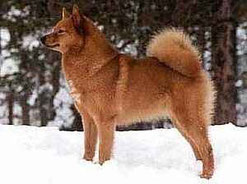Russian Laikas
Based on an article from Kennelgazet, volume 1, nummer 7
Russian Laikas are multifunctional hunting dogs, used in the expansive Siberian forests by professional hunters, for hunting all different kinds of wild game. There are 3 official FCI recognized breeds: the West Siberian Laika, the East Siberian Laika and the Russian-European Laika. The latter is closely related to the Karelian Bear
Dog. There is a 4th breed, however, but this breed can only be found in Russia and is not recognized by the FCI: the Karelo-Finnish Laika. This breed looks very much like the Finnish Spitz. It is likely that it is the same breed, separated in two by artificial human borders.


Laikas are Spitz dogs, an ancient type of dog which is very characteristic for the entire Northern hemisphere. In all Northern countries you can find several regional variances of Spitz-like dogs. Some of them were originally used for hunting, others were used as shepherd dogs, guard dogs or sled dogs. For centuries, these breeds have mainly developed by natural selection. Only in the last decades, selective, organized and conscious breeding takes place. Laikas should be able to meet extreme circumstances, like cold and snow, and also need to be intelligent enough to be able to survive on their own.
Siberian hunters could not afford to keep several dogs, each specialized in different kinds of game. Therefore, a Laika should be capable to do whatever his owner requires. If there is something
wrong with the dog, or if it is not a competent hunting dog, it is simply killed. This is the reason
why these breeds have developed into powerful and healthy dogs, although their general appearance may differ. The hunters themselves live in the wilderness, in their opinion a Laika is part of
the nature and the forest is his natural habitat.
In former times, Laikas used to be considered simple and modest farm dogs, mainly kept by aboriginal people who lived in outlying parts of Russia, while the noble Russians hunted with noble dogs like Barzois and with thoroughbred horses. As a result, Laikas were not paid much attention to and not much has been written about this breed until the 1920’s. Since then, hunters started to show more interest in these all-round dogs, but only after the Second World War appropriate breeding has started. Dogs from far wilderness regions were taken to big cities, like St. Petersburg, and were used to improve the breeding programs.


About 10 years ago, the Russian Kennel Club was established. Before that, there were several associations for hunters and their dogs, for working dogs and for ‘decorative’ dogs. Hunters, however, were not very interested to enter the organized world of pure-bred dogs nor to seek international co-operation. And still they are not very enthusiastic about the idea that Laikas are gaining more and more popularity in Western Europe as show and family dogs. They want to preserve the original hunting qualities and consider this the most important breeding goal. In the past, but even nowadays, dog shows are more like breeding selections where mainly the dog’s functional aspects are judged.
Laikas have a friendly nature. They are very sensitive and they have the capability of learning many commands. Although males are easily tempted to participate in a fight with other males, these dogs are always friendly and reliable – never aggressive -
because of the fact that many city people with ‘green’ ideas consider a Laika exotic and charming, these breeds have also towards people. Because of these qualities and found friends among non-hunters.
Nevertheless, nowadays a Laika is mainly a dog owned by hunters who are not interested in dog shows, championship titles and even not in field trials. They say that Laikas are so intelligent because they realize very quickly that a field trial is not a serious hunt, but just a game and because of that, they are not even trying to do what they are supposed to do. Therefore, usually the results are disappointing compared to the dog’s true qualities. This is the reason why people who would like to compete with their dogs, choose another breed. In Russia there are competitions and Laikas are used for hunting all kinds of different game, from bear and moose to squirrel, and from wild boar to mink and birds like duck and grouse.


note:
According to an agreement, the Finnish Spitz and the Karelo-Finnish Laika will be treated as one breed from 5th July 2006. From this date, both breeds are registered in the FCI breed standard as the breed Finnish Spitz (FCI-no. 49). Reason
for this descision is expanding the genetical basis.
The differences between the 3 breeds are not always very clear because the exterior is not very important to a hunter, as long as the dog is capable of doing his job. For breeding, hunting skills are far more important than size, colour or the shape of the head. Therefore, it is not always easy to separate the breeds, unless a dog is well-representing 1 of the 3 breeds.
Mainly in areas where hunting is a professional sector, not many pure bred Laikas can be found, as for breeding, the dog's hunting quality is the only thing that counts. Therefore, every dog is tested and it is very common that a professional hunter leaves with a number of dogs and returns from the forest with only a few of them. The others did not meet the requirements and were simply killed and left behind. Most pure bred Laikas can be found in and around urban areas, where they are kept by non-professional hunters.
Furthermore, because of the fact that in the past and in many areas also nowadays, travelling in Russia is difficult and the distances are very long, several different regional populations with small differences
occur within one breed.
The estimated Laika population in Russia is about 65.000 individuals. Furthermore, there are a number of unregistered dogs, owned by hunters. After Russia, Finland probably has the largest Laika
population, followed by the other Scandinavian countries. In most European countries, Laika breeds are known, but the number of Laikas in those countries is small and the dogs can rarely be seen
at dog shows. This is understandable, because of the small demand for these kinds of hunting dogs. Nowadays, in most European countries it is no longer possible to hunt large game. Wild boar is
quite common, but moose only exist in the North. Hunting bears is not allowed, or at least followed by strict rules in countries with large bear populations. Keeping bears for testing dogs is
absolutely forbidden in the Western world. Nevertheless, breeders and judges should respect these breeds’ origins, in case Laikas would become an attractive show and family dog in the future and
the original character should not be manipulated.



